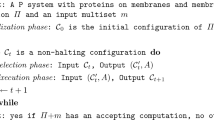Abstract
Sudoku, of order n, is a logical puzzle with an objective to fill a partially completed \( n^{2} \times n^{2} \) grid, such that it’s each row, column and n × n sub-grid, also called box, contains the digits ranging from 1 to n 2, exactly once. It is known to be a NP-complete combinatorial problem. In this paper, a parallel and distributed framework of cell-like P-systems is presented to solve Sudoku puzzles. For this, the number of membranes including skin membrane is equal to the size of puzzle, i.e., n 2 for Sudoku of order n. This P-system model has total of 6 rules to solve the puzzle, out of which five are evolution or update rules while one is communication rule. The model solves “easy”, “medium”, and “hard” puzzles of the studied database with 100% success rate. However, in the “evil” category some of the problems could not be solved, the reason of which is also explained in this paper. From the numerical results, it is concluded that the majority of the Sudoku puzzles could be solved in a very small computational time.








Similar content being viewed by others
References
Das KN, Bhatia S, Puri S, Deep K (2012). A retrievable GA for solving Sudoku puzzles. Technical report. http://www.cse.psu.edu/~sub194/papers/sudokuTechReport.pdf
Delahaye JP (2006) The science behind Sudoku. Sci Am 294(6):80–87
Deodhare D, Sonone S, Gupta A (2014) A generic membrane computing-based Sudoku solver. In: 2014 international conference on issues and challenges in intelligent computing techniques (ICICT) (pp 89–99). IEEE
Díaz-Pernil D, Fernández-Márquez CM, García-Quismondo M, Gutiérrez-Naranjo M, Martínez-del-Amor MA (2010) Solving Sudoku with Membrane computing. In: 2010 IEEE fifth international conference on bio-inspired computing: theories and applications (BIC-TA) (pp 610–615). IEEE
http://www.menneske.no/sudoku/eng/top10.html. Accessed between Jun to Jul 2015
http://www.websudoku.com/. Accessed between Jun to Jul 2015
Inkala (2006). http://www.aisudoku.com/index_en.html. Accessed between Jun to Jul 2015
Kovacs T (2008) Artificial intelligence through search: solving Sudoku puzzles. Technical report, Department of Computer Science, University of Bristol, (2008). http://www.cs.bris.ac.uk/Publications/Papers/2000948.pdf
Păun G (2000) Computing with membranes. J Comput Syst Sci 61(1):108–143
Sato Y, Hasegawa N, Sato M (2011) GPU acceleration for Sudoku solution with genetic operations. In: 2011 IEEE congress on evolutionary computation (CEC) (pp 296–303). IEEE
Takayuki YATO, Takahiro S (2003) Complexity and completeness of finding another solution and its application to puzzles. IEICE Trans Fundam Electron Commun Comput Sci 86(5):1052–1060
Acknowledgements
The first author acknowledges Ministry of Human Resource Development, Government of India for funding this research work under Grant No. MHRD02-23-200-304.
Author information
Authors and Affiliations
Corresponding author
Rights and permissions
About this article
Cite this article
Singh, G., Deep, K. Cell-like P-systems using deterministic update rules to solve Sudoku. Int J Syst Assur Eng Manag 8 (Suppl 2), 857–866 (2017). https://doi.org/10.1007/s13198-016-0538-8
Received:
Revised:
Published:
Issue Date:
DOI: https://doi.org/10.1007/s13198-016-0538-8




